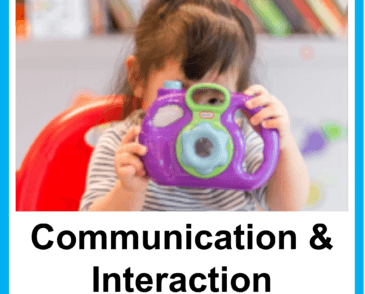

Last Updated - February 5, 2025
Supporting the learning environment – Early Years – Communication and Interaction
Ensure to provide a ‘total communication environment’ in the setting. This involves the adults as well as the physical provision. Building a total communication environment means making subtle and simple changes to our communication and environment so that we can improve interaction and understanding.
Aim for the 20 key features of a good ‘total communication environment’
- Consistency – we must be consistent in the way we communicate with children. It is important to all use the same form of communication when communicating with certain children.
- Signing systems – where possible give the sign (or gesture) as well as the spoken word, this doubles the impact of the message, making it easier to understand.
- Access – put pictures and objects in places that are accessible – both for reach and visually.
- Language level – remember, if a child has an understanding at a one-word level – use one word. Long sentences containing lots of information will be wasted. If you use more than one word, back it up with a visual, or a sign or gesture. Be aware and remember to pitch your language at a level that the listener will understand and give them plenty of time to process the information. Avoid language overload!
- Questions – know when to use open and closed questions (closed question require a short answer, often “yes” or “no”, open questions seek longer answers).
- Give time to process, understand and respond – the processing speed of some children may be impaired, and they may need up to 10 seconds or more to process a message (count silently in your head).
- Eliciting language – you cannot force a response. Asking a child to say a word does not mean they understand what they are saying. It is better to put language in, than try and pull it out. Provide opportunities for a response e.g. talk about what the child is doing, expand on their language, start a sentence but let them finish it.
- Adaptation – if you are not being understood, be flexible, adapt your message. Change the language or complexity of language. Change the mode of communication – e.g. from verbal to picture. Give the child other ways to respond –sign, gesture etc. Give them more time to process. Change your goals if things are not working.
- Back-up – have a back-up set of resources that you can access when trying to help someone understand. Have a gesture or communication dictionary for each individual so that new people know what the individual is trying to communicate.
- Awareness of sensory sensitivities – some communicators have sensory sensitivities, hearing or visual impairment or are easily distracted. For this reason, it is important to provide an environment with the right lighting and a reduction in background noise etc.
- Use your body and face – use body language and gesture, use your facial expressions, they all lend weight and cues to your message.
- Face to face – make sure you are facing the child, be at their level and look at the child you are communicating with.
- Use touch – it may help children to understand activities, people and places.
- Use texture and objects – in their simplest form, textures or objects can be used to give children an idea of what is about to happen e.g. give them a spoon and they know it’s time for lunch, or a towel before going swimming etc.
- Use environmental cues – use the cues that are all around us and build on them. They can include pictures, logos, colours, noise and texture.
- Use pictures and visuals – visuals and pictures can work for many children with communication difficulties. Visual strategies can be used in a multitude of ways to enhance understanding and expression. They are particularly useful for non-verbal individuals, children with learning difficulties and / or those with autism.
- Use print – using a printed word or recognisable symbol system may be helpful when other forms of communication fail.
- Assistive Technology / Assistive communication (AAC) – under the guidance of a Speech and Language Therapist (SALT), some children may use assistive and adaptive communication devices such as iPads or Talking Tins with a focus on facilitating communication.
- Use your speech and voice – many people with communication impairment are still able to use their voice and speech. As a speaker, be aware of the complexity of the language you are using.
- The environment – it is important to create an environment that is conducive to communication. Provide good lighting and reduce background noise or distractions.
View and/or download the Torbay Early Years Toolkit here: Torbay Early Years Graduated Approach Toolkit – Family Hub
